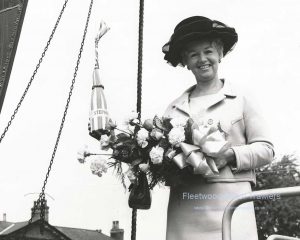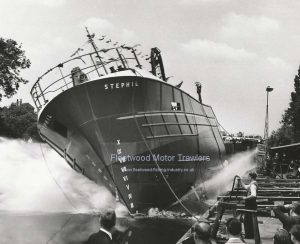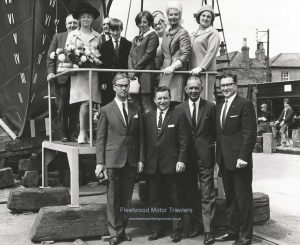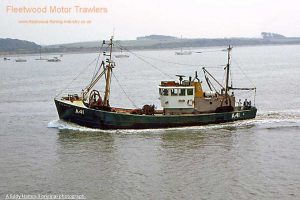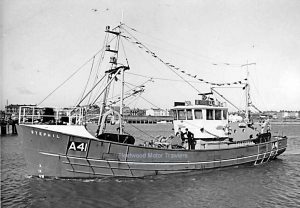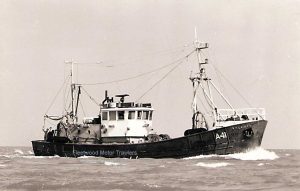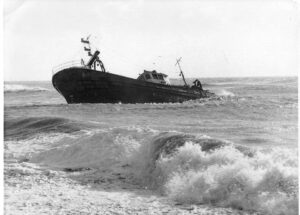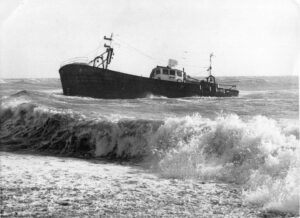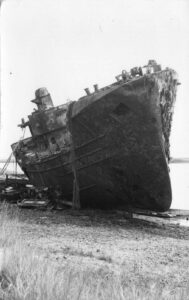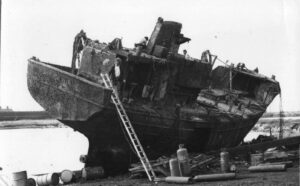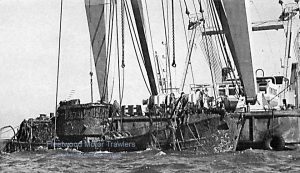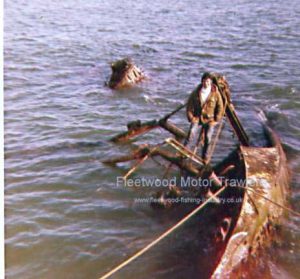Technical
Gross Tonnage: 48
Net Tonnage: 48
Length: 73 ft
Breadth 19′ 6″
Depth: 10 ft
Built: Richard Dunston Ltd, Thorne, 1968
Engine: Lister Blackstone turbo charged model ERS4MGR. Diesel 330bhp, 750 Rpm
History
1968: Completed by Richard Dunston Ltd, Thorne, for Stephil Trawling Company LTD, Lancashire, as STEPHIL.
31.10.1970: In Morecambe Bay, steering gear disabled. Weather deteriorating rapidly and STEPHIL began drifting and became fouled in her nets. Mayday sent.
CRAIGMILLAR, (Sk. Richard Farrer) and LONDON TOWN (Sk.Charles Pook) responded and CRAIGMILLAR made five attempts to tow the STEPHIL back to port but the foul weather broke the towline time and time again. Meanwhile, LONDON TOWN kept a vigilant eye on the situation.
STEPHIL crew launched RFD and boarded CRAIGMILLAR before STEPHIL stranded on Walney Island.
Efforts were made to secure the vessel but she was swept away and sank.
1972: Wreck raised by the floating barge TAKLIFT-1 (United Towing Co Ltd, Hull). TAKLIFT-1 moved the wreck to Wyre Light but it was discovered that the crane could not fit through the lockpits. STEPHIL was discovered to be too badly damaged by her stay on the bottom off Walney Island, that she was eventually taken to Barrow and broken up.
Crew: Skipper Ray Barkworth,Vic Barkworth engineer, Bill Edwards mate and Charles Hambly deckhand.
Note
As 90MPH gales lashed her island home, Peggy Braithwaite, Britain’s only female lighthouse-keeper, peered into the afternoon storm at the stricken vessel lying some miles away on the beach below.
From her vantage point atop Walney light she could make out the grim shape of the pocket-trawler which she later described as being “bounced on the beach by the waves.”
Later that November day in 1970, she saw the ship tugged relentlessly from her moorings, swept from the South Hawes shoreline, and deposited in the Barrow channel. The elements had won, and the tiny trawler sank from view. Fortunately however, Barrow harbor officials had taken bearings of her last position – a detail which was to be crucial in later developments.
The 40ft craft was one of a new-style miniature fishing vessel known in the trade as a ‘Sputnik’ trawler and used for local and Scottish coastal fishing. Her name – STEPHIL.
STEPHIL’s visit to Peggy Braithwaites back yard, so to speak, had been very brief. It had arrived on her shores after an 18-hour drama which had begun three days earlier on the last day in October of the year, 1970.
The STEPHIL had sailed early morning that Saturday but ran into two unfortunate events: One was that the steering gear broke down, the other was that the weather went from bad to worse and then to near hurricane conditions.
There were four Fleetwood men on board: Skipper Ray Barkworth with his brother Vic as engineer, Bill Edwards as mate and Charles Hambly as deckhand.
As the seas grew mountainous, STEPHIL – uncontrollable – became enmeshed in her own net and began drifting 25 miles across Morecambe Bay. All attempts to free the propeller failed and with the vessel tossing like a cork the Skipper radioed for help. As always in these circumstances the fishing fraternity lost no time in providing assistance.
Out of the tempest came another pocket-trawler CRAIGMILLAR and a near-water trawler LONDON TOWN.
Reports say that CRAIGMILLAR, with Skipper Richard Farrer aboard, made five attempts to tow the STEPHIL back to port but the foul weather broke the towline time and time again.Meanwhile, LONDON TOWN under control of Charles Pook, kept a vigilant eye on the situation. If the CRAIGMILLAR got into difficulties too, he would have a real mess on his hands.
All the time the little circus of ships and wind and wave were bearing relentlessly towards the shallows of Walney Island beach. Shallower water meant crashing waves.
Although reports say that Barrow Lifeboat was launched and that the Liverpool Lifeboat was underway, there was actually no time to lose and the gallant men who provided our fish had to make some swift decisions.
Recently I was able to track down one of STEPHIL’s crew, three of whom were young men at the time but whom I knew would now be in there fifties and sixties – if still alive.
Bill Edwards, mate of the STEPHIL those near thirty years ago, was still living on Hathaway Road. I showed him one of the pictures accompanying this article and asked him if the photo meant anything to him. Bill had never seen the illustration before but it took only seconds before he said, “It’s the STEPHIL!”
I asked Bill about those last moments as the storm-tossed trawler drove towards Walney’s treacherous shore. “We were in shoal waters,” said Bill, remembering vividly. “If the ship drove ashore and rolled over, we would be inside and that would have been the end. I could hear the Skipper talking on the radio to Dick Farrer on the CRAIGMILLAR. Whether he realized it or not, I told him in no uncertain terms that we needed to get the hell out of it and I went on top of the bridge to get the life-raft ready.”
With some agility the four crew-members clambered into the life-raft (a Beaufort six-man re-flatable dingy, often referred to as an RFD) and they made the tortuous trip across 200 yards of heaving seas towards the CRAIGMILLAR.
“It was a credit to seamanship,” Bill recalled. “Jake Hogg, bosun on the Craigmillar, had fastened a heavy shackle to a length of twine and he hurled it, spot on, across the life-raft. Of course, we lost no time in grabbing it and, hand over hand, via a heavier rope attached to it, we made are way towards the safety of the CRAIGMILLAR.”
With skill, Dick Farrer got the CRAIGMILLAR around to them and they were hauled aboard on the lee side. It was half-an-hour to midnight as the brave rescue vessels battled their way to the safe haven of Fleetwood port.
Meanwhile, the ill-fated STEPHIL drove hard onto Walney Island to lie stranded, west-by-south of Morecambe Bay lighthouse. During the days following, attempts were made to secure her to the land by ropes but come Tuesday 3rd November, 1970, the weather rose to gale-force winds and under Peggy Braithwaite’s surveillance, the tragic vessel was swept away and sank as described earlier.
As the months wore on, attempts were made to do something about the STEPHIL until finally, one sunny September day, two years later, a Dutch firm was subcontracted to deal with the sputnik at the bottom of the sea. With lines drawn under the vessel the mammoth 800 ton lifting rig TAKLIFT I brought STEPHIL back to light, from the darkness. Then they began the ticklish 25 mile tow across the bay towards Fleetwood.
The giant rig couldn’t get through the dock lock-pit and the STEPHIL, it was hoped, could perhaps be floated-in. The trawler, however, was quite unstable and the huge rig, with STEPHIL still strung like a puppet from the 120ft jib, had to make the journey 25 miles back to Barrow where she was surveyed but condemned to the scrap heap. A sad end for a top-of-the-range sputnik type trawler.
Bill Edwards told me he had to scroll to commemorate the day they did their ‘Evil Knevil’ (remember him?) from STEPHIL to CRAIGMILLAR in their RFD. Seemingly at the time these craft were rather in their infancy as regards suitability for their use in dangerous seas. Those who used them (or who were so unfortunate as to land up in a situation necessitating their use) were made members of the ‘Porpoise Club.’
Bill dug out his 28 year old certificate scroll and showed me. He smiled. “Somewhere I’ve got a tie, as well. It has a blue porpoise on it…
Click to enlarge images
Changelog
05/12/2016: Page re-published due to site problems.
31/12/2017: Removed FMHT watermarks and added an image.
11/10/2021: Added images.

